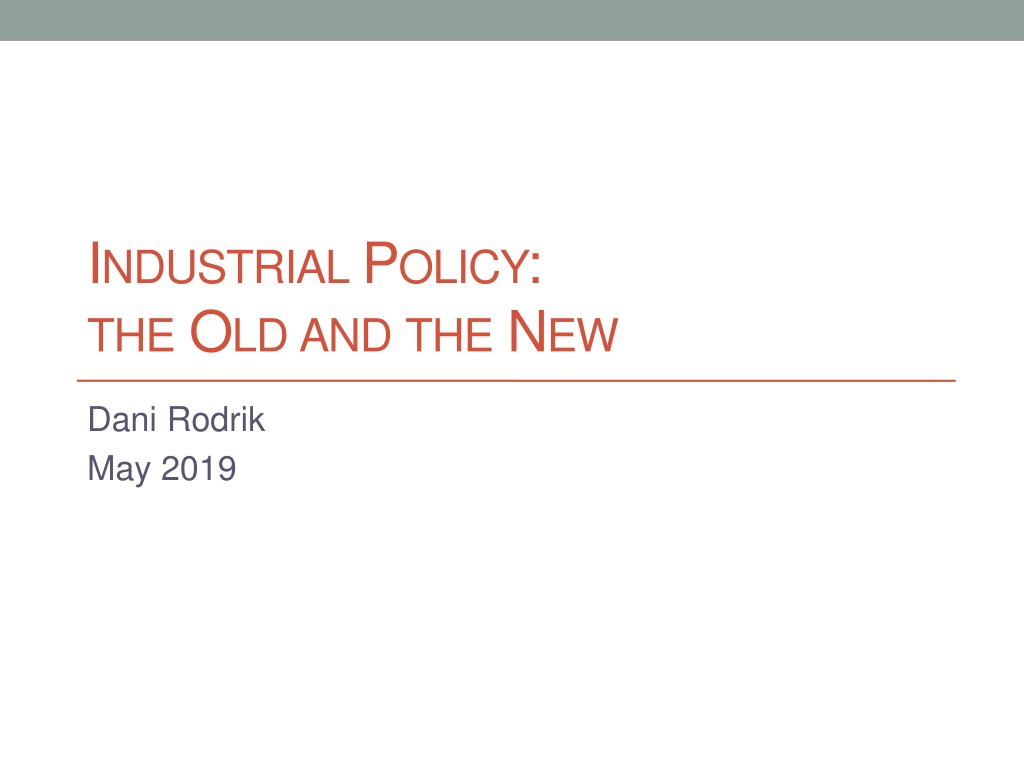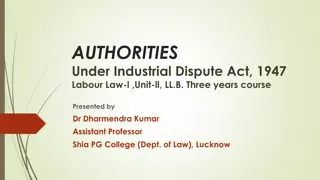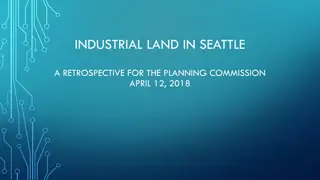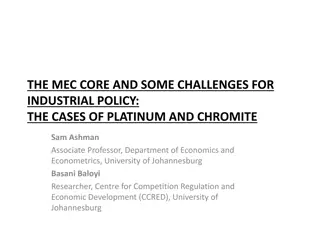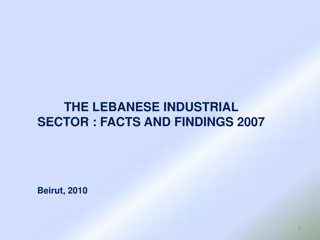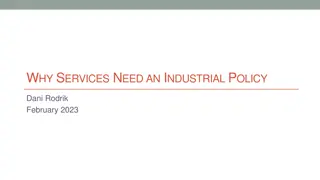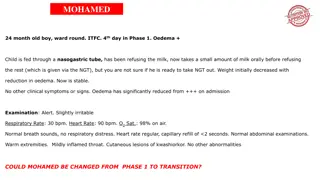Industrial Policy: The Old and The New - Insights by Dani Rodrik
Industrial policy, as presented by Dani Rodrik in May 2019, emphasizes the importance of empirical work, the differences between old and new policies, and the targets industrial policy should focus on. The theoretical arguments for industrial policy highlight market imperfections, learning spillovers, coordination failures, and structural changes that support the case for its implementation. However, the practical implementation of industrial policy faces obstacles such as lack of information and political capture. The debate surrounding industrial policy centers on conflicting views on these obstacles, with examples from countries in East Asia showcasing successful industrial policy strategies despite challenges.
Download Presentation

Please find below an Image/Link to download the presentation.
The content on the website is provided AS IS for your information and personal use only. It may not be sold, licensed, or shared on other websites without obtaining consent from the author. Download presentation by click this link. If you encounter any issues during the download, it is possible that the publisher has removed the file from their server.
E N D
Presentation Transcript
INDUSTRIAL POLICY: THE OLD AND THE NEW Dani Rodrik May 2019
Key questions and answers What have learned from experience with IP? not clear empirical work can go only so far How does new IP differ from old? relaxing assumptions of hard state and omniscience institutional design can counteract negative side effects successful IP does not require picking winners What should IP target? an IP for good jobs
The strong case for industrial policy in theory Few economists doubt that the market imperfections on which the theoretical arguments for IP are based do exist, and are often pervasive (1) Learning spillovers R&D externalities demonstration effects from pioneer firms in new industries spillovers from the introduction of new products or new technologies (e.g., garments in Bangladesh, HYVs in India ) upstream spillovers from FDI (e.g., auto plants, retail) dynamic scale economies and LBD (e.g., steel, semiconductors) (2) Coordination and agglomeration failures clusters (e.g., tourism and electronics ) upstream and downstream linkages production and supply chains specialized labor skills industry-specific public goods (e.g., standards, transport/logistics) More broadly, it is recognized that growth entails structural change (from traditional, low productivity activities to new, higher productivity activities), and that the process of structural change is rife with market failures.
The ambiguous case for industrial policy in practice Insurmountable obstacles to the practice of IP? Lack of information can governments identify the relevant firms, sectors, markets subject to those market imperfections? Political capture can governments withstand lobbying and rent-seeking to prevent IP from becoming an instrument of rent transfer to connected insiders? 1) 2) Thus, the debate on IP revolves not around its theoretical merits, but around sharply conflicting views regarding the relative importance and pervasiveness of these obstacles look at how difficult it all is but look at countries in East Asia who have done it
Does empirical work help? (1) Informal evidence comparisons of policy regimes e.g., ISI in Latin America, national champions in Europe case studies plenty of successes (POSCO, Embraer, Chilean salmon, ) as well as failures (Concorde, African white elephants, Proton, ) suggestive at best unclear counterfactuals pervasive problem of selection bias rarely subjected to explicit cost-benefit analysis Cross-section econometrics did subsidized industries do better? large number of studies, going back to 1980s Krueger and Tuncer (1982), Harrison (1994), World Bank (1993), Lee (1996), Beason and Weinstein (1996), Lawrence and Weinstein (2001), has the usual econometric complications of specification, omitted variable bias, measurement, etc. but its problems run much, much deeper
Why is econometric work on the efficacy of IP difficult? (1) Consider the contending theoretical perspectives on government behavior the developmentalist view: gov t can successfully identify and support growth-enhancing firms/sectors the inefficacy view: gov t seeks growth, but cannot pick successfully the rent-seeking view: gov t is beholden to special interests Can we discriminate among these perspectives by observing gov t behavior and consequences across firms/industries?
Why is econometric work on the efficacy of IP difficult? (2)
Why is econometric work on the efficacy of IP difficult? (3)
Why is econometric work on the efficacy of IP difficult? (4)
Why is econometric work on the efficacy of IP difficult? (5) The association between intervention and economic performance is negative under a developmental government, precisely what we would also find under a rent-seeking government!
Why is econometric work on the efficacy of IP difficult? (6) Problem here is that government policy is not random; it responds to economic/political pressures What about causal identification through standard econometric techniques, such as IV and RD? econometric identification requires exogeneity and exclusion requirements to be satisfied; even if there are such instruments/thresholds, results can be difficult to interpret we want to know the effects of purposeful IP, when it is (a) targeted at the underlying problem, (b) shaped by political considerations, or (c) some combination thereof not when it is conducted randomly (or in a manner that is orthogonal to its economic justification and political determinants) randomization cannot help when the debate is largely over whether government can/does select appropriately
Why is econometric work on the efficacy of IP difficult? (7) State of the art: Criscuolo, Martin, Overman, and Reenen, Some Causal Effects of an Industrial Policy (AER 2019) causal effects on employment (and other outcomes) of investment subsidies in UK identification through changes in eligibility criteria for regions, set by EU authors argue changes in (some of) these criteria were exogenous to relevant economic conditions in UK, which is plausible answers: what are the effects of investment subsidies, comparing randomly treated regions to others? not: what are the effects of investment subsidies, in regions selected by government (through a mix of motives), compared to the counterfactual of providing these regions with no subsidies? Critics (of both kinds) may remain unconvinced positive result? opponent of IP: yes, but in practice IP (here, the selection of regions) will be politically driven, and these results do not directly speak those, more realistic cases negative result? proponent of IP: yes, but these results do not speak directly to subsidies appropriately targeted on regions that could make the most use of them
Where does this leave us? strong theoretical justifications for policy intervention inconclusive empirical evidence on whether policy works on average just like education policy (human capital externalities) health policy (moral hazard, adverse selection) social insurance and safety nets (incomplete risk markets, behavioral factors) infrastructure policy (natural monopoly) stabilization policy (Keynesian rigidities ) in all these areas, it is recognized that the market-failure arguments for intervention can be exploited by powerful insiders and overwhelmed by informational asymmetries and evidence on efficacy remains contested, despite rich empirical literature but policy discussions typically focus not on whetherthe government should do it, but on how debate on what works and under what conditions thinking about IP requires a similar shift
What kind of industrial policy? How should IP be conducted? traditional versus modern IP Which market failure(s) should IP target? frontier innovation? technology spillovers? supply chains? fostering entry and competition? rent-shifting ( national champions )? de-industrialization? good jobs ?
Traditional versus modern industrial policy Traditional IP (the East Asian model) top-down: a list of sectoral priorities + sectoral incentives presumes honesty, competence, adequate implementation presumes solutions are known perfected in paradigmatic East Asian cases (S. Korea, Taiwan) Modern IP a process of institutionalized collaboration and dialog focused on identification of constraints and opportunities and the generation of pragmatic private-public solutions continuous monitoring and evaluation presumes competence and trust can be developed over time does not presume solutions are known; merely that they can be discovered characteristic of many current initiatives
Institutional design for modern industrial policy Four key ideas, each of which leads to a different design principle : 1. The requisite knowledge about the existence and location and magnitude of market failures and constraints are diffused widely within society => embeddedness 2. IP is subject to high dimensional uncertainty: solutions are local, contextual, and unknown ex ante => iterative collaboration 3. Businesses have strong incentives to game the government => carrots and sticks 4. The intended beneficiary of IP is neither bureaucrats nor business, but society at large => accountability
Design features for IP institutions: embeddedness & iterative collaboration Economists tend to think of policy design in top-down, principal-agent terms takes informational incompleteness and asymmetries as given, while keeping the private-sector at arms length This model has the advantage that it gives bureaucrats autonomy and protection from private sector rent-seeking, but it has the disadvantage that it severely restricts the flow of information from below businesses cannot communicate information about the constraints they face other than through their actions More appropriate model lies in between the two extremes: high-bandwidth collaboration between the private sector and the government with the aim of uncovering where the most significant bottlenecks are deliberation councils, supplier development forums, search networks, investment advisory councils, sectoral round-tables, private-public venture funds, development banks,
Design features for IP institutions: embeddedness & iterative collaboration IP as a process of ongoing discovery rather than as a list of policy instruments focusing on learning where the binding constraints lie, rather than on whether you should use tax breaks, R&D subsidies, credit incentives, and so on Experimentation, monitoring, and revision in policies
Can governments pick winners? This is the wrong question Success in IP is determined not by picking winners but by letting losers go given uncertainty, optimal policy strategies will necessarily produce mistakes challenge is not to avoid mistakes altogether, but to ensure that mistakes are recognized as such and entail phasing out of support a much weaker requirement than omniscience governments may not be able to pick winners, but they can recognize losers Can democracies experiment? focus on portfolio of projects, not individual projects Solyndra versus Tesla; Fundacion Chile; NRC study
Principles in application across wide range of domains U.S.: DARPA, ARPA-E technological frontier; Azoulay et al. (2018); Goldstein and Narayanamurti (2018); Khosla and Beaton (2017) U.S.: manufacturing institutes new manufacturing technologies; Block et al. (2018); Deloitte (2017) U.S.: Project QUEST workforce development; Rademacher et al. (2001), Roder and Elliott (2019) Peru: sectoral roundtables identifying and removing sectoral bottlenecks; Ghezzi (2017) Argentina: modern agriculture intense public-private collaboration, supported by Argentine Technology Fund (FONTAR) and the National Institute of Agricultural Technology (INTA) for finance, technology and legislation (Sanchez et al., 2011) Smart development banks search engines for cost discovery; Fernandez-Arias et al. (2018)
What kind of industrial policy? How should IP be conducted? traditional versus modern IP Which market failure(s) should IP target? frontier innovation? technology spillovers? supply chains? fostering entry and competition? rent-shifting ( national champions )? de-industrialization? good jobs ?
Absence of good jobs as negative externality A widespread and serious problem: polarization in labor markets Not just a matter of equity and inclusion, but also a source of gross inefficiency Costly externalities social costs: broken families, drug abuse, crime W.J. Wilson 1996, Autor, Dorn, and Hanson 2018 political polarization and rise of populist parties Autor et al. 2017, Dal B et al. 2018, Colantone and Stanig 2016, 2017, Guiso et al. 2017 authoritarian values Ballard-Rosa et al. 2018, Colantone and Stanig 2018 Aggravated by current trends in technology, globalization, de- industrialization Inadequacy of conventional remedies education, UBI, redistribution, job guarantees, fiscal policy
Concluding words A need to normalize IP not whether but how ? pragmatic rather than ideological approach A need for IP that targets good jobs Critical role of the quality of government-business dialog IP a misnomer productivist policy?
New versus old type of IP assumptions practice theory policy dimensionality evidence Traditional governments know market failures but prone to capture ex ante selection of policy instruments and priority sectors (e.g., S. Korea) externalities + principal-agent low cross-industry, cross-firm econometrics, augmented by IV, RD and natural experiments Modern market-failures unobservable ex-ante; requisite information widely dispersed; state capacity endogenous identification of objectives & constraints through strategic collaboration with firms (e.g. Peru) collaborative learning, cost- discovery, error- detection, PDIA high informal, contextual, portfolio evaluation against ex ante benchmarks
Design features for IP institutions: carrots and sticks Without rents for entrepreneurs, there is too little investment in cost discovery and other activities that promote structural change Schumpeter s insight: entrepreneurship requires rents rents as second-best mechanisms to alleviate market failures in innovation patents are the obvious example But open-ended rents bottle up resources in unproductive activities Hence the need for carrots and sticks incentives and disciplines conditional subsidies, sunset clauses, monitoring and evaluation,
Design features for IP institutions: accountability If bureaucrats monitor businesses, who monitors the bureaucrats? Need for mechanisms of transparency and accountability a high-level political principal and champion for IP activities someone associated with IP activities and who can be held politically responsible as with monetary policy (cf. CB independence) clear statement of objectives with monitorable targets mechanisms of transparency publication of requests from business regular dissemination of activities accounting of expenditures processes that are open to new entrants as well as incumbents periodic accounting of what was done and why (cf. inflation targeting)
